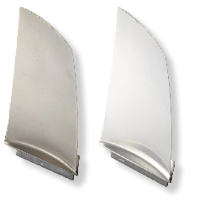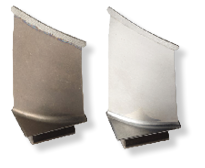
Aero engine turbines and compressor blades are subject to high temperatures and pressures, forcing manufacturers to implement strict regulations for production and processing methods.
Aerospace engine blades are typically made of difficult-to-machine materials and have tolerances that must be met to obtain suitable air flow and maximum wear resistance. These components are exposed to temperatures up to 1,000°C, requiring blade surfaces to be high quality and optimized to the conditions in the engine. To meet these demands, OTEC Precision Finish developed a process to improve the efficiency and safety of engine blades and produce fewer defects.
Smoothing the air foil (the blade body) has a positive impact. Depending on the required result, the surface can be smoothed to values of up to Ra < 0.2µm in a few minutes, increasing blade efficiency. The material is removed evenly and only a minute amount is taken from the surface. Repairing the leading and trailing edges with precision rounding can reduce the quantity of rejected parts. Upstream machining process, such as blasting, can damage these edges, so OTEC’s method enables them to be rounded to a given radius and repaired.
Stream-finishing results
Deburring the root improves safety by preventing the blade from getting caught in the disc. Surface treatment prolongs the service life of the blades and increases efficiency, and this preparation is also suitable for coating components.

In OTEC’s stream-finishing process, the blades are clamped into the machine and lowered into a container of abrasive. The container rotates, moving workpieces in the media flow. Flow to the blades in the machine is clocked, so the workpiece’s alignment angle changes at frequent intervals, allowing processing to be precisely aligned to specific points on the workpiece, achieving a smooth surface and precise rounding without altering the blade’s shape. Depending on the size and initial condition of the workpiece, surface treatment of engine blades takes between 2 minutes and 20 minutes, significantly less time than conventional processes. Blades are individually clamped, so no damage will occur to the workpiece surface. All processing steps can be carried out in one SF-5 stream finishing system that can process up to five engine blades at once for high output and cost efficiency. Tests conducted after OTEC processing show positive results for residual stress, fatigue strength, and fluorescence control.

Explore the May 2019 Issue
Check out more from this issue and find your next story to read.
Latest from Aerospace Manufacturing and Design
- AAMI project call submission deadline extended to May 12
- Jergens launches cast iron tooling column additions
- Airbus to acquire assets relating to its aircraft production from Spirit AeroSystems
- FANUC America's Cobot and Go web tool
- Chicago Innovation Days 2025: Shaping the future of manufacturing
- High-density DC/DC converters for mission-critical applications
- #59 - Manufacturing Matters: Additive manufacturing trends, innovations
- ACE at 150: A legacy of innovation and industry leadership





